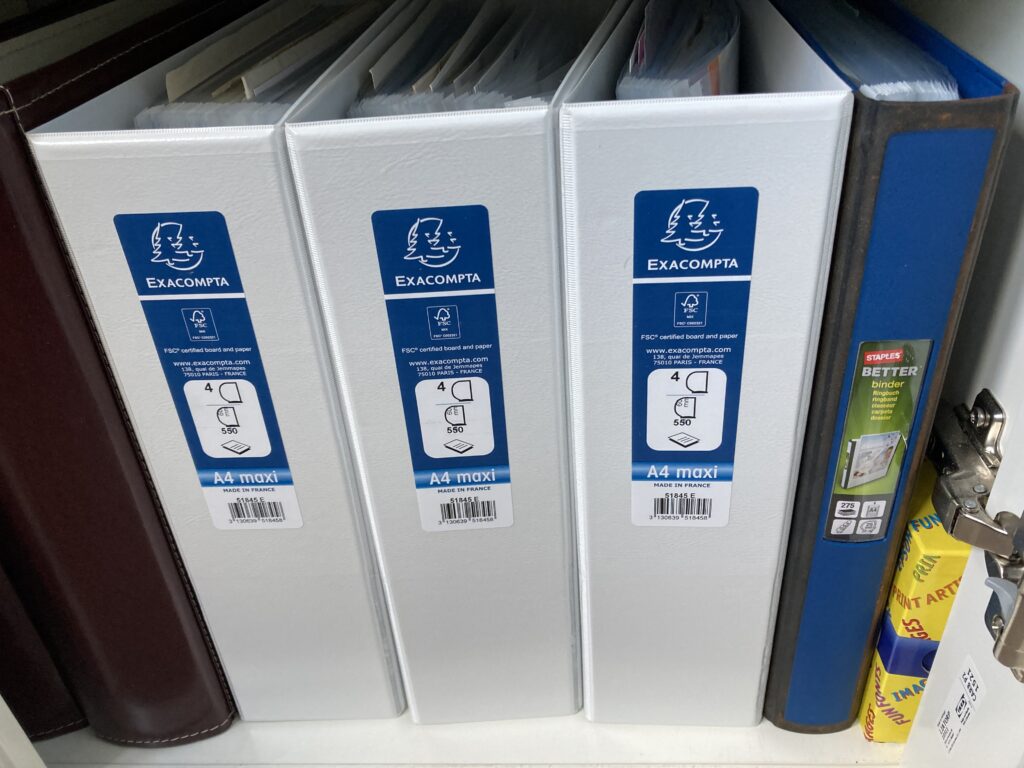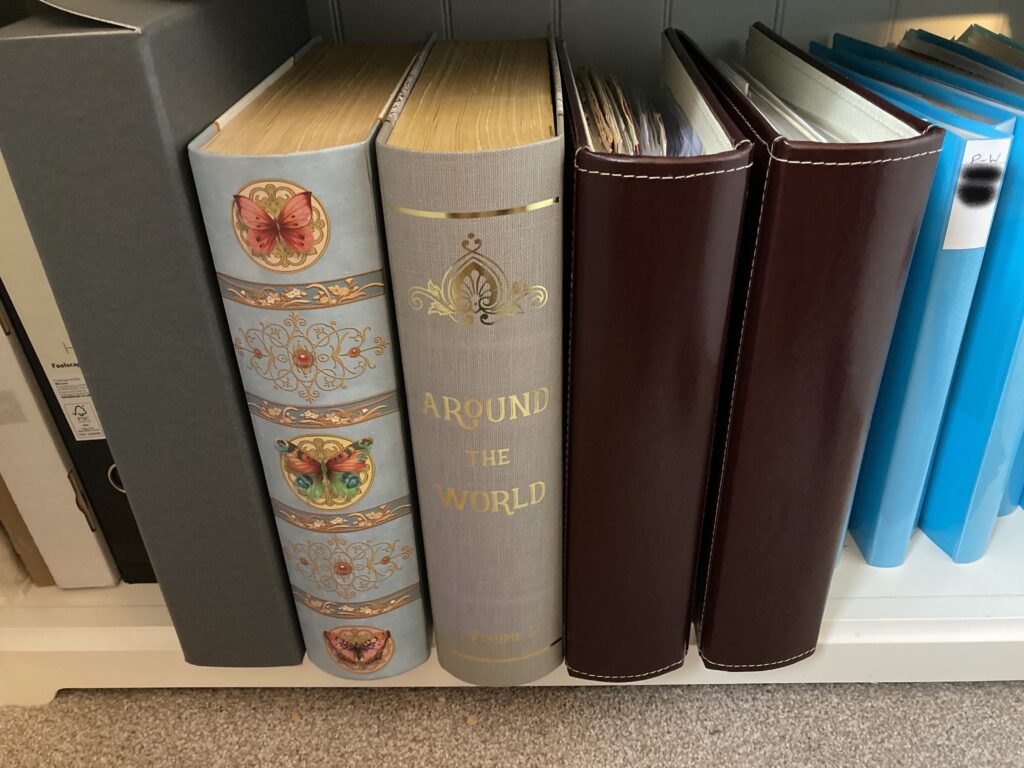The original objective of this Object Obliteration journey was to eliminate some of the physical mementos and letters that I have, and to store them in more effective containers in less space. In the event, I destroyed relatively few physical items – just 88 or 12% of the total 710; but do now have much more satisfactory containers, though unfortunately taking up slightly more space than before.
The most prominent reasons for keeping items were that they were reminders of people or events special to me, and a desire to have particular items visible and easily accessible to peruse at my leisure. Underlying these reasons seems to be a feeling that a physical folder makes its presence known to you every time you notice it, and that the items within it are somehow a limited number of special objects which are there to be looked at. Having the items in the physical folder means that they won’t be forgotten. A set of digital files, however, is essentially invisible, and you have to make an effort to go and look for it. Furthermore, it doesn’t feel like a self-contained entity with a specific set of contents that you are perusing – just an indefinite series of very similar entities on a single flat screen. In summary, I think I was keeping the things I would definitely want to look at again, in the knowledge that they would be placed in a physical folder which would mean I wouldn’t forget them and could get at the whole set easily and quickly without having to do any searching.
The other prominent reason for keeping items was that they, in some way, told a significant story about me, my work and my life. I wanted to be able to revisit that material, and/or for others to be able to have easy access to that material after I am gone. Having said that, I was under no illusions that most of the mementos and all of the letters are of little or no interest to anyone but myself, so any thoughts of others looking at the material at any time and be interested by it, was really just wishful thinking which, nevertheless, did influence my choices.
Two interesting observations emerged from the exercise. First, as I moved the mementos into their new, more ordered homes, I began to think they would benefit from some kind of index, or even a summary of their contents. I wondered if this is a generic phenomenon: that, as things become more orderly and are housed in more prestigious containers and spaces, so the urge rises in us humans to provide guides to, and information about, the material.
Second, two different sets of material gave me cause to think they would be easier to access and read digitally than in their original physical forms. These were a set of 8 pocket diaries, and a whole series of greetings cards. Both types of material are a little more difficult to store than a plain page of paper; and access to both can involve more than a quick look at a single image (an obvious point for the multi-page diaries, but it also applies to larger cards which have to be stored in their folded state). Since, I have a digital copy of every item, whether it is retained in physical form or not, this realisation simply impacts how I access the material: the decision to keep or destroy such physical objects will usually be dictated by other rationales as illustrated by the variety of reasons for Keeping and Destroying recorded in this journey.
For both Mementos and Letters the overriding reasons I recorded for destroying items was that they were of no special interest or significance (69% of the reasons given), and they concerned someone who I only vaguely knew or have lost touch with (12%). However, it’s clear from my notes that, for those 88 items I did destroy, it wasn’t such a traumatic decision. I knew that the contents would still be intact and available in a digital copy even if the physical missive was not, and this made it easier to destroy the physical item. In the face of this unarguable fact, I didn’t feel that I had fully obliterated any of those items. They still lived on, even if in other forms. This realisation prompted me to dig a little deeper into what would constitute total obliteration from the human perspective; and, my musings led me to think about three different components of this phenomenon: a physical item, a digital copy, and the memory we have of the item in our minds. Perhaps, I thought, true obliteration requires that all three be destroyed so that the human observer no longer has any perception of the object, and the object makes no impact on the human.
Further exploration of these three types of object – physical, digital, and memory – throws up some interesting observations.
- Originals and copies: Each of the three types of object can be an original object or a copy. Physical objects are easy to think of as originals; and they can be copied by artisans, by a 3-D printer, or in a manufacturing process. Digital objects are created in files, which can then be copied or printed out. Any thought can first be created in someone’s mind (the original memory object), and then be written down (the copy). Examples of original memory objects might be things like an idea for a painting or a storyline for a book; and the resulting painting or book could be considered to be copies of those memory objects (though uncertainty about how exact the copies are is a considerable complication).
- Adjustability: Physical objects would seem to be less easy to adjust than digital objects; while memory objects seem to be much more fluid and may not only be adjusted by circumstances or time, but also be embellished by related items or events. Furthermore, I know from my own experiences, that memories of objects, at any given time, may or may not be incomplete, inexact or sometimes, just plain wrong.
- Transitions: an original object of any one of the three types can be transitioned into a copy in one of the other types. For example, a digital photo can be taken of a physical original; a digital file can be copied into a physical book; and an idea in someone’s memory can become a digital PowerPoint slide. However, such transitions always incur both the gaining and the loss of some characteristics. For example, in the transition of a physical object to a digital copy texture is lost and code is gained; and from digital to memory (as when looking at a digital photo) the ability to expand is lost, and the memory of it is embellished by the place in which you saw it.
- Transmission: From the human perspective, memory enables the transmission of information and knowledge within an individual from one day to the next; from one year to the next; and from one part of life to another part of life. The transition of memory to verbal, written, or other form (either physical of digital) enables the transmission of memory from one human to another within a lifetime, and across lifetimes.
- Obliteration of originals: If an original is obliterated (say, a physical object is destroyed, or a digital object is deleted, or a memory object is completely forgotten) the object may still be available to be perceived in a physical or digital copy, either within the originator’s lifetime, or sometime in the future.
- Actions on object types: An interesting way of comparing the characteristics of such objects is to look at whether humans can carry out various actions on them. The table below examines the following actions: Perceive, Describe, Adjust, Combine, Transmit, and Destroy.
| Perceive | Describe | Adjust | Combine | Transmit | Destroy | |
| Physical | Yes | Yes | Maybe | Maybe | Yes | Yes |
| Digital | Yes | Yes | Yes | Yes | Yes | Yes |
| Memory | Yes | Yes | Not explicitly | Not explicitly | Only by transitioning | No |
- IT Impact: IT has introduced a massive number of new original and copy objects, and made the transition and transmission of memory objects and physical objects much, much easier. In addition to introducing all these completely new objects, IT has also had an impact on physical and memory objects as summarised in the table below.
| Perceive | Describe | Adjust | Combine | Transmit | Destroy | |
| Physical original | Computer imaging and magnification enables greater detail to be seen | No impact | By physical machinery controlled by IT | By physical machinery controlled by IT | By computer managed transport | No impact |
| Physical copy | Computer imaging and magnification enables greater detail to be seen | No impact | By physical machinery controlled by IT | By physical machinery controlled by IT | By computer managed transport | No impact |
| Memory original | No impact | No impact | No impact | No impact | No impact | No impact |
| Memory copy | No impact | No impact | No impact | No impact | Digital files/email enable thoughts to be stored and sent | Digital material can be deleted |
- Other questions: A number of obvious questions might be asked after considering the above material. For example: Are Physical, Digital, and Memory objects actually objects in their own right regardless of whether they are originals or copies? Does being an original confer greater authenticity? Is a digital object containing a part of a digital original, a copy of that original?
Having toyed with all these thoughts, I returned to my original notion that true obliteration requires that all three representations of an object (physical, virtual and memory) – be destroyed; and I’m inclined to think that is the truest position to take. After all, if I have memory of an object and can talk about it and write about it, the object is clearly still having an impact on me; and, to my mind, it is ‘impact’ that obliteration is intended to eliminate. Unfortunately, memories are not either there or not there – they get forgotten, become less precise, and get recalled as fragments – so this isn’t a very precise or useful notion. The only thing we can be sure of is that an individual’s memory of an item is destroyed when the individual dies (at least, that is currently the case). So perhaps it’s best to leave human memory on one side, and to just focus on physical and digital originals and copies. These, at least, can be perceived and assessed with a degree of certainty. My conclusion from this narrowed perspective, is that obliteration involves the destruction of all physical and digital originals and copies. This would exclude mere references to an object in a document or a verbal description of an object by an individual – though it would also have to entail the destruction of an object (such as a photo) which is included within a larger object. I’m not too sure if this is a useful conclusion, or that these deliberations have been worthwhile; but at least the question about what object obliteration means in the digital age, hasn’t been left unexplored.




